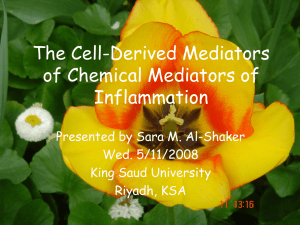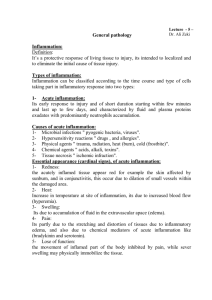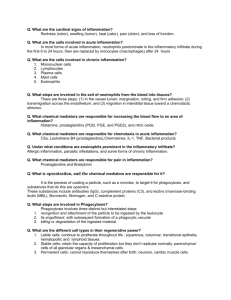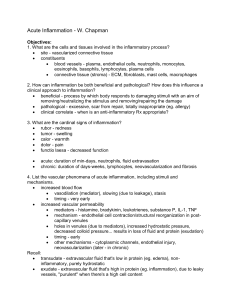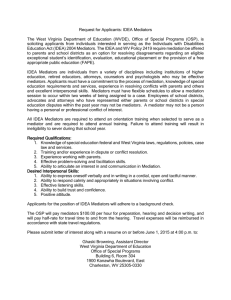L3-Inflammation
advertisement
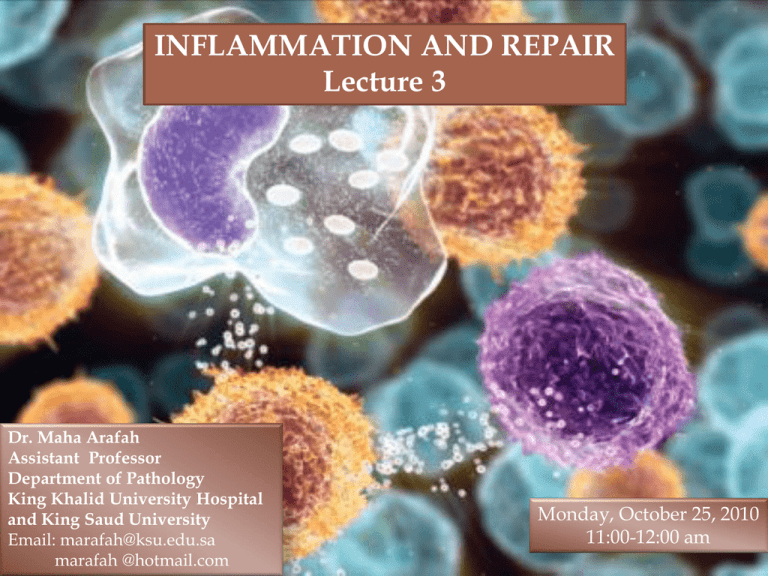
INFLAMMATION AND REPAIR Lecture 3 Dr. Maha Arafah Dr. Maha Arafah Assistant Professor Department of Pathology King Khalid University Hospital and King Saud University Email: marafah@ksu.edu.sa marafah @hotmail.com Monday, October 25, 2010 11:00-12:00 am 1 Upon completion of this lecture, the student should: 1. 2. 3. 4. 5. Define the chemical mediators of inflammation. Know the general principles for chemical mediators. Know the cellular sources and major effects of the mediators. List the most likely mediators of each of the steps of inflammation. List and describe the outcome of acute inflammation. What are mediators? • Chemical mediators of inflammation are substances produced during inflammation inducing a specific events in acute inflammation. - The production of active mediators is triggered by: microbial products 2. host proteins, such as the proteins of the complement, kinin and coagulation systems 1. ( these are themselves activated by microbes and damaged tissues) - - 1) 2) 3) Most mediators have the potential to cause harmful effects. Therefore, there should be a mechanism to checks and balances their action. Mediator function is tightly regulated by: decay (e.g. AA metabolites) inactivated by enzymes (kininase inactivates bradykinin) eliminated ( antioxidants scavenge toxic oxygen metabolites) Plasma-derived: 1. 2. 3. Complement kinins coagulation factors Cell-derived: 1. 2. Many in “pro-form” requiring activation (enzymatic cleavage) Synthesized as needed (prostaglandin) Preformed, sequestered and released (mast cell histamine) Chemical Mediators of Inflammation Cell-Derived Plasma-Protein-Derived Vasoactive Amines Eicosanoids PAF Cytokines Chemokines ROS NO Lysosomal Enzymes of Leukocytes Neuropeptides Chemical Mediators of Inflammation Cell-Derived Plasma-ProteinDerived Complement Coagulation and Kinin Systems Producing cells: Tissue macrophages Mast cells Endothelial cells Leukocytes Among first mediators in acute inflammatory reactions Preformed mediators in secretory granules Source: many cell types, esp. mast cells, circulating basophils, and platelets Stimuli of Release: Physical injury Immune reactions C3a and C5a fragments Leukocyte-derived histaminereleasing proteins Neuropeptides Cytokines (e.g. IL-1 and IL-8) Actions: 1. 2. 3. ARTERIOLAR DILATION INCREASED VASCULAR PERMEABILITY (venular gaps) ENDOTHELIAL ACTIVATION Inactivated by: Histaminase Source: Platelets Action: Similar to histamine Stimulus: Platelet aggregation Source: Leukocytes Mast cells Plasma-Protein-Derived Endothelial cells Platelets Chemical Mediators of Inflammation Cell-Derived Vasoactive Amines Eicosanoids PAF Cytokines Chemokines ROS NO Lysosomal Enzymes of Leukocytes Neuropeptides Chemical Mediators of Inflammation Cell-Derived Plasma-Protein-Derived Vasoactive Amines Eicosanoids PAF Cytokines Chemokines ROS NO Lysosomal Enzymes of Leukocytes Neuropeptides Chemical Mediators of Inflammation Cell-Derived Plasma-Protein-Derived Vasoactive Amines Cytokines Polypeptides Eicosanoids Actions: PAF Involved in early immune and inflammatory Cytokines reactions Chemokines Some stimulate bone marrow precursors to produce more leukocytes ROS NO Lysosomal Enzymes of Leukocytes Neuropeptides Cytokine of Acute inflammation: Interleukin (IL-1) & TNF Chronic Inflammation: Interferon-γ INF- γ & Interleukin ( IL-12) Activated lymphocytes and macrophages influence each other and also release inflammatory mediators that affect other cells. Chemical Mediators of Inflammation Cell-Derived Plasma-Protein-Derived Vasoactive Amines Chemokines Small proteins Eicosanoids They are chemoattractants for leukocytes PAF Main functions: Cytokines Leukocyte recruitment & activation in inflammationChemokines Normal anatomic organization of cells in ROS lymphoid and other tissues NO Lysosomal Enzymes of Leukocytes Neuropeptides Chemical Mediators of Inflammation Cell-Derived Plasma-Protein-Derived Reactive Oxygen Species Vasoactive Amines Synthesized via Eicosanoids NADPH oxidase pathway PAF Source: Cytokines Neutrophils and Macrophages Stimuli of release:Chemokines Microbes ROS Immune complexes NO Cytokines Action: Lysosomal Enzymes of Leukocytes Microbicidial (cytotoxic) agent Neuropeptides Chemical Mediators of Inflammation Cell-Derived Plasma-Protein-Derived Vasoactive Amines Nitric Oxide ( NO) Short-lived Eicosanoids Soluble free-radical gas PAF Functions: Vasodilation Cytokines Antagonism Chemokines of platelet activation (adhesion, aggregation, & degranulation)ROS Reduction of leukocyte recruitment NO Microbicidial (cytotoxic) agent (with or Lysosomal Enzymes of Leukocytes without ROS) in activated Neuropeptides macrophages Chemical Mediators of Inflammation Cell-Derived Plasma-Protein-Derived Lysosomal Enzymes Vasoactive of Leukocytes Amines Neutrophils & Monocytes Eicosanoids Enzymes: PAF Acid proteases Neutral proteases (e.g. elastase, Cytokines collagenase, & cathepsin) Chemokines Their action is checked by:ROS Serum antiproteases (e.g. α1-antitrypsin) NO Lysosomal Enzymes of Leukocytes Neuropeptides Chemical Mediators of Inflammation Cell-Derived Plasma-Protein-Derived Vasoactive Amines Neuropeptides Eicosanoids Small proteins PAF Secreted by nerve fibers mainly in lung & GIT Initiate inflammatoryCytokines response e.g. Substance P : Chemokines Transmits pain signals ROS Regulates vessel tone NO Modulates vascular permeability Lysosomal Enzymes of Leukocytes Neuropeptides Neuropeptides Small proteins Secreted by nerve fibers mainly in lung & GIT Initiate inflammatory response e.g. Substance P : Transmits pain signals Regulates vessel tone Modulates vascular permeability Chemical Mediators of Inflammation Cell-Derived Plasma-ProteinDerived Complement Coagulation and Kinin Systems A variety of phenomena in the inflammatory response are mediated by plasma proteins that belong to three interrelated systems 1. Kinin 2. the complement 3. clotting systems Kinin & clotting systems enhanced leukocyte adhesion & activation increases vascular permeability, pain increases vascular permeability, Chemotaxis Complement System C3a & C5a Increase vascular permeability (^ histamine) anaphylatoxins C5a Chemotaxis C3b Opsonization C5-9 membrane attack complex Role of Mediators in Different Reactions of Inflammation Vasodilation Prostaglandins Histamine Nitric oxide Increased vascular permeability Vasoactive amines Bradykinin Leukotrienes C4, D4, E4 PAF Substance P Chemotaxis, leukocyte recruitment and activation C5a Leukotriene B4 Chemokines IL-1, TNF Bacterial products Fever IL-1, TNF Prostaglandins Pain Prostaglandins Bradykinin Tissue damage Neutrophil and macrophage lysosomal enzymes Oxygen metabolites Nitric oxide Acute inflammation may have one of the four outcomes: Complete resolution Healing by connective tissue replacement (fibrosis) Progression of the tissue response to chronic inflammation Abcess formation 32 33 Events in the resolution of inflammation 34
